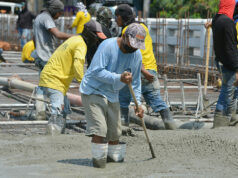Raw Honesty: Found In Sashimi
By Joseph L. Garcia, Reporter
THE WORD “raw” can capture an image of boorishness. We humans think that something is only worthy of attention when it has been touched by our numerous complications. It takes a certain elegance and skill to present food safely and tastily in its rawest form, for example, sashimi. In sashimi, there is a communion between nature and humanity, the tongue getting a taste of what the universe has created in its truest, most honest, and yet proudest form, aided with minimal intervention by the human hand.
With more than 20 years of experience under his belt, Chef Keiichi Hirukawa has a deep understanding of his canvas: in this case, fish. Mr. Hirukawa, the new Head Sushi Chef at Nobu in City of Dreams, introduced himself by preparing a luncheon on Aug. 15.
The definition of what we consider elegant shifts through time: sushi was once simply a way to preserve fish using the fermentative properties of rice. Now, sushi can be the most elegant meal one can have. In the same vein, all-too-familiar Filipino food has reached an elegance known now not only in homes, but on the palates of gourmands around the world. Mr. Hirukawa married both disciplines in his luncheon, a skill that he might have achieved growing up Japanese in Florida. He carved his career as Sushi Chef in Kiyoshi’s Japanese Restaurant in Florida from 1998 to 2006; and as a co-owner and Head Chef at Florida’s Kanpai Sushi and Sake Bar from 2007 to 2010. He also served as a Head Chef in California’s Wokcano from 2010 to 2014, and in Cho Cho San from 2014 to 2016. Mr. Hirukawa’s culinary career also led him to be the Sushi Chef at The Izakaya by Katsuya from 2015 to 2017 before finding his way to Nobu Malibu as the Sushi Chef from 2017 to the early months of 2019, immediately before joining Nobu Manila.
For the luncheon, which served as a preview to Nobu’s eight-course Omakase dinner (there are two menu options: a seasonal one featuring new creations which changes every month, and another featuring Nobu signatures), Mr. Hirakawa opened with Salmon with Gata (coconut milk) sauce and Amazu, a Japanese sweet and sour sauce. It had a freshness that shocked the tongue into life, perfect for opening up the palate for the next course, a three plate special featuring Tuna Sisig, Emperor Adobo, and Belt Fish with Chimichurri. A small bite of the Tuna Sisig conjured a memory of a full meal replete with a beer. The Emperor Adobo, meanwhile, had a memory of crispness in it despite not being crispy at all. The Belt Fish, meanwhile, was unbelievably fresh, as if one had just scooped the fish out of the water just prior to the luncheon.
The third course was a Yellowtail Kare-Kare with Karashisumiso Bagoong (think bagoong with an infusion of miso, mustard, vinegar, and yuzu — though frankly, I’m not sure what the chef’s recipe was).
Well, that was — amazing. The fish of course had a silky texture, and who knew the taste of raw fish could be so… proud? Despite the improvement from the Kare-Kare, it still stood out — forgive the pun — swimmingly.
A Grilled Umami Chicken with Tomato Salad, an aggressive dish unlike its precedents, ended the savory courses, and Nobu’s signature Miso Cappuccino served as dessert, and made the guests beg for seconds.
An intimate knowledge of his chosen medium is needed for his craft, and BusinessWorld asked if it was difficult for him to work with the fish in the country. Mr. Hirakawa answered, “I don’t want to put down the Philippines, but it’s a little bit different. You still find [it] fresh, because you’re surrounded by the ocean. Quality-wise, you can get quality fish here. But sometimes with the culture difference, the way they handle it, in the heat — you know, that makes a little bit of difference.”
Asked if working with fish is a different game from working with other ingredients, he said, “As long as the fish is fresh. There’s no difficulty. Once you learn the basics of how to play with fish, then you determine by the meat, whether it’s soft, or oily — you learn as you do this for a long time.”
“Tuna is my favorite,” the chef answered gamely in an interview with BusinessWorld, despite a reticence we observed during the course of the luncheon. “Oily fish is my favorite. Oily — it just melts. Tuna — something about its rustic taste, I guess. A kind of steely taste. I like it a lot.”
As we’ve mentioned, the preparation of raw food is a communion of nature and human skill, a responsibility that Mr. Hirukawa does not shrug off casually. Asked if raw food is more difficult to prepare, he said, “Of course it is. To maintain that, to handle it, to store it, whatever, at a certain temperature… It has to be fresh, it has to be fast. It doesn’t sit in room temperature. Fresh, fresh, fresh.”
In Muriel Barbery’s Gourmet Rhapsody, food critic Pierre Arthens is dying in bed, and takes the reader down his memories of his best meals. In a reverie about sashimi, he compares the skill of the chef to a sculptor and then says, “The sculptor merely unveils the shape — for talent consists not in inventing shapes but in causing those that were invisible to emerge.”
“Skill — you have to have a heart. You have to love this. You have to be passionate about it. I think that’s more important. Skill and stuff, little by little it will come, if you want it,” said Mr. Hirukawa. “If he has skill, he’ll get paid. But if he doesn’t have passion, he’s not going to create.”
“Taste is just something I play with. I play around and if I see you smiling, and you have a reaction from it, that’s all I need.”



